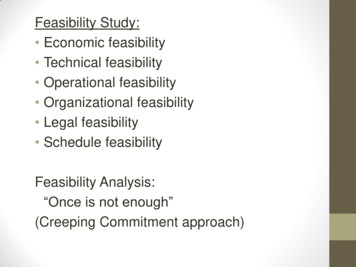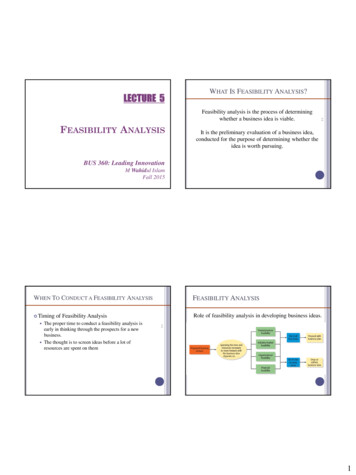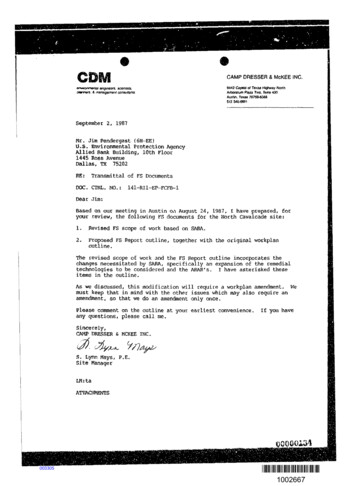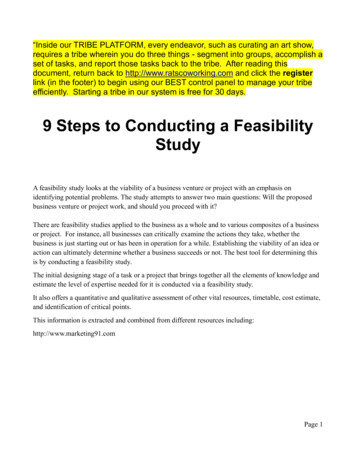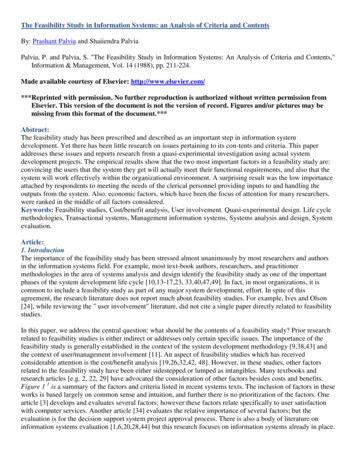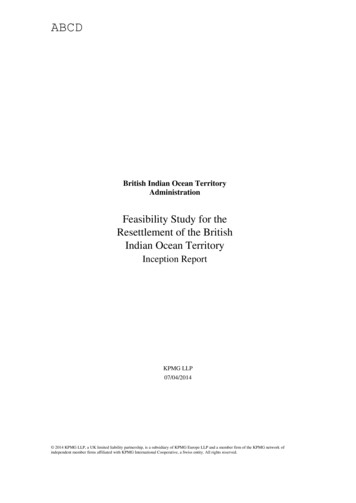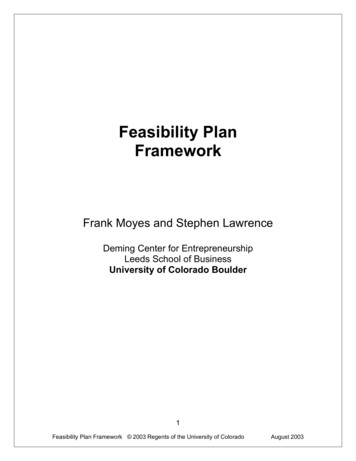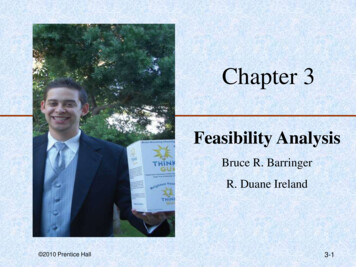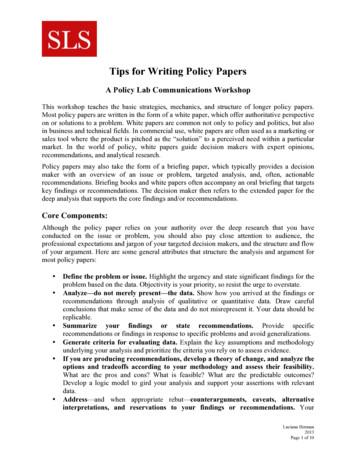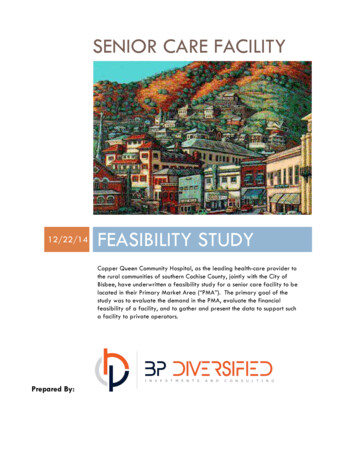
Transcription
SENIOR CARE FACILITY12/22/14FEASIBILITY STUDYCopper Queen Community Hospital, as the leading health-care provider tothe rural communities of southern Cochise County, jointly with the City ofBisbee, have underwritten a feasibility study for a senior care facility to belocated in their Primary Market Area (“PMA”). The primary goal of thestudy was to evaluate the demand in the PMA, evaluate the financialfeasibility of a facility, and to gather and present the data to support sucha facility to private operators.Prepared By:
Senior Care FacilitySenior Care FacilityCONTRIBUTORSWithout the support and contributions from the following this report would not be possible.Copper Queen Community Hospital (“CQCH”)Jim Dickson – CEOJohn Charley – Project ManagerKathleen Heard – Chairman of the BoardCity of Bisbee (“The City”)Jestin Johnson – City ManagerDavid Smith - Ward II CouncilmemberDouglas Dunn - Ward II CouncilmemberBisbee School DistrictElias Jouen – Business ManagerJim Phillips – SuperintendentiBisbee CommitteeStanley Stern – ChairReal Estate Stakeholder’sDavid Greenberg – REMAXRichard Newbill – Bisbee Realty, Inc.Scott Ries – KW CommercialLeroy Brockbank – Copper Queen RealtyBP Diversified Investments and Consulting (“BPD”)Benjamin Pozez – Founder and Principal ConsultantPage 1
Senior Care FacilityProject OverviewFor years, CQCH has noted a continuing trend in the population it serves, it’s aging. While this is not a newtrend nationally, and has been anticipated with the “baby-boomer’s” reaching retirement age, the BisbeeRegion has significantly lagged national trends of senior-care facility development. CQCH Mission is to“Maintain and support access to basic primary healthcare throughout Southern Cochise County byexcelling in leadership, vision and service delivery to address opportunities and challenges tohealthcare.”CQCH is wisely exploring the demand and possible impact a Senior-Care Facility could have on their servicedelivery model, the overall achievement of their mission, and the region as a whole. Further to this, CQCHcontacted the iBisbee Committee to help it explore the potential of development. The iBisbee Committee wasformed by the City Council to help market the city and bring new business and development to the formercopper mining town. With a strong recommendation from the iBisbee Committee, the City of Bisbee agreedto share the costs of the study, as it serves to benefit a large portion of the community, as well as potentiallylead to economic and employment growth in the region.After a competitive bid process, CQCH in conjunction with the iBisbee Committee selected BP DiversifiedInvestments and Consulting to perform the Feasibility Study. BPD has extensive knowledge of both the SeniorCare Industry and regional development trends, with a breadth of research normally limited to companiesoutside of Southern Arizona. Their team is lead by company Founder and Principal Consultant BenjaminPozez.PRIMARY MARKET AREA (“PMA”)The Primary Market Area (“PMA”) is a 1,825 Square Mile Polygon located in the South Eastern most cornerof Cochise County (see map below). Within the PMA, Douglas is the largest “Metropolitan” area, although it is still rural.Page 2
Senior Care FacilityEXECUTIVE SUMMARYAfter reviewing all of the available market demand and economic data points, BPD finds very strong marketindicators for senior-care facilities to be developed in the PMA. With an older population, relatively stableincomes, very levels of low mortgage debt, and a low cost of development and operations, the Bisbee regionshould be able to attract quality developer’s/operator’s to the PMA. The size, and scope of services offeredby the facility will ultimately be determined by an individual operator, but it is clear that market demandexists in excess of current capacity.The key demographic data found during this study are;1.) Population Demand Indicators:a.) There are currently over 5,750 resident aged 65 and over, representing over 15% of thetotal population.b.) Assuming the overall market capture is only 5% of the demographic target market, thereis currently demand for over 280 beds in the region (more than double current capacitywhen excluding Sierra Vista).2.) Economic Demand Indicators:a.) Average income is relatively strong at 43,957, but median income is still of concern,especially with those aged 75 and over. Of those over 75, over 57% of them are livingon incomes below 25,000 annually.b.) Average net worth is also very strong, but may be skewed significantly by a few verywealthy residents. The median net worth of those over 75 is in excess of 140,000though, although illiquidity in the residential housing market may be a major hindrance toa developer/operator.c.) With relatively narrow gaps between average and median home value, it is safe toassume that home value in the region is stable, and not terribly price sensitive, with bothaverage and median value between 99,000- 120,000.3.) Competitive Indicatorsa.) While the market is not currently over-saturated, there are certainly facility choices thatalready exist in the region, with a particular concentration in Sierra Vista (located outsidethe PMA).b.) Currently Planned development in Sierra Vista is a positive indicator that demand isoutpacing supply.c.) Scale is certainly going to be the core issue in differentiating from the current competitivelandscape. Most of the current facilities are smaller 5-10 bedroom operations, and aslightly larger multi service approach could be well suited to the region.Indicators on facility type show that while specialty care (skilled nursing/dementia/Alzheimer care) isunderserved, the financial viability of this as a stand-alone model is low. Ultimately, the population base isnot large enough to support a specialized facility type, and a broad continuum of needs will have to beserved to reach a large enough client base for financial viability.Preliminary research into the availability of real estate has also been positive, with both land available fordevelopment, as well as other facilities that could potentially be converted. While BPD did not do extensivedue diligence on any individual conversion property, the overall cost of a conversion could far out way thecost of new construction, but will be dependent on the operator’s model.Page 3
Senior Care FacilityEXECUTIVE SUMMARY CONTINUEDIt is also important to consider the cooperation and support the City of Bisbee and CQCH have alreadydemonstrated to this project, and how that may ultimately help a developer/operator. Clearly the City ofBisbee can explore some Public Private Partnership structures to enhance certain sites for a developer, andfurther to that, CQCH may be able to lend significant support or services to an operator.Another primary concern for any operator is always the labor pool (especially in rural markets), however,BPD found that the Cochise College of Nursing has an excellent program, and has been providing highlyqualified nurses to the labor pool of the PMA for many years.While affordability was certainly a concerned raised by many during the study, it appears that a veryhealthy percentage of the population in the PMA can afford the average cost of care. With a combination ofthe economic indicators discussed above, as well as supporting programs from state and federal agency’s, theoperators primary concern in relation to affordability will be proper facility scale.BPD’s own Demand Assessment Model, shows current demand in the PMA to support a facility as large as 36beds. With that said, BPD believes an operator could be better served to enter the market on a smallerscale, 10-20 beds to start, while planning for future growth.In conclusion, BPD believes strongly in the feasibility and financial viability of a senior care facility center tobe located in the PMA, and will continue to lend its support in attracting a high quality developer and/oroperator to the PMA.Sincerely,Benjamin J PozezPrincipalBP DiversifiedPage 4
Senior Care FacilityAPPROACH AND METHODOLOGYAfter an initial kick-off meeting, a preliminary list of key individuals was developed for personal interviews byBPD. Based on this initial stakeholder list, BPD traveled throughout the county and conducted personal interviewswith key stakeholders and senior service providers. To update and refine previous project research, a follow-upcommunity survey and/or Town Hall meetings were discussed and rejected as unnecessary based on the overallcompetitive landscape.BPD utilized qualitative and quantitative analysis to prepare this feasibility study for the City of Bisbee, andCQCH. Considerable information was collected from community leaders, local residents, and project stakeholdersconcerning the near-and-long term needs of the elderly and the vision of senior care facility. Informal discussionswere held with local residents, business owners, and county and state agency representatives to investigateownership, management and facility options. Research was conducted to identify existing competitive facilities, aswell as overall affordability and payment methods for an operating facility.The demographic information contained in this Study is included to define the characteristics of the City of Bisbeeand Cochise County senior populations as indicators of the need for expanded senior services and the ability tosupport and maintain a physical facility.A Senior Profile developed through demographic data alone is not an indicator of the potential success or failureof this project. The demographic profile highlights important factors for consideration, potential demand forservices, statistical data for long-term planning, and serves as a baseline of information for future independentproject analysis.The State of Arizona Department of Health Services defines seniors as 65 years of age and older, and thereforethis is the population sector attributed to utilization and/or demand for senior services. Younger seniors mayrequire assistance with activities of daily living due to falls, fractures or the absence of a caregiver and mayconsider moving to a facility at an early age. Therefore, an age qualification of 75 years or older is typicallyused to measure the demand for assisted living services.The following Senior Profile offers a micro and macro analysis of this population sector as indicators of both shortterm demand and longer-term sustainability. For purposes of this market profile, Cochise County and City of Bisbeedemographics for the population 55 years of age and older are also considered to identify trends and changes inthis segment of the population and as an indication of the future demand for Range of Senior Living Options.The Senior Profile is a more short-term analysis of the senior population to address the more immediate demandfor expanded senior services. The long- term projections demonstrate the potential for long-term projectsustainability. Census data and the short-term population characteristic are essential to identify immediate unmetneeds.Data sources utilized include: ESRI, REIS REPORTS, CDC, AZDHS, AZDES, US CENSUS DATAPage 5
Senior Care FacilityINTRODUCTIONThis Study provides information on identified community needs, facility type and site location recommendationscombined with market, cost and revenue analysis information for public or private project development. The Studyis compatible with the industry standards for long term care, incorporates the needs of the community withconsideration given to the limited health and social services available to area residents due its geographic locationand proximity to larger population centers.Bisbee, and the surrounding rural areas of Cochise County constituting the PMA area (1,825 sq. miles)geographically diverse. The county borders Mexico on the south and shares a border with New Mexico to theWest. The terrain is characteristic of the desert: large open spaces, spectacular mountains and hills, fertile valleysand picturesque views of the desert. The economy was primarily driven by the mining industry for a century, buttransitioned to an Arts and Tourist driven economy over the last several decades.Each of the small communities in the PMA offers a rich and colorful history, unique cultural characteristics and anindependent spirit. Due to the rural nature of the County, many services and amenities found in larger populationcenters are either not available or the selection is limited.Medical services and support services for the elderly are limited in the smaller towns and communities throughoutthe county. However, many of the communities have medical clinics, resident emergency medical technicians (EMTs)and well-functioning senior centers. A noteworthy characteristic of the towns and communities, and rural residents, isa sincere concern and responsibility for their family, friends and neighbors - with particular attention to the elderly.Copper Queen Community Hospital is a rural acute care critical access hospital that has been providing convenient,affordable health care to the area it serves for over 125 years. CQCH operates three Rural Health Clinics viaCopper Queen Medical Associates, located in Bisbee, Douglas and Palominas. The local medical staff includes 30physicians: 17 fully active physicians and 13 consultants. The hospital provides a broad range of inpatient andoutpatient services, including acute care; outpatient surgery; 24-hour emergency services; cardio-pulmonaryservices; rehabilitation services; home health care; an occupational medicine department; a full-service laboratory;and diagnostic imaging, on-site experienced and professional radiologists, and tele-radiology for speedydiagnostic capability. CQCH serves more than 25,000 patients, many of whom are unemployed, have low familyincomes, and are uninsured or underinsured.Initial Project Research: Phase IPhase I of this Feasibility Study, which focused on the Demographic and Market Demand Indicators(incorporated within), was initiated March 25th, 2014, with initial drafts circulated in mid April. The finalPhase I report was presented to the public June 18th, with a recommendation to follow on with Phase II. In the1st week of September, the City of Bisbee and The Copper Queen Community Hospital initiated Phase II ofthis study, which is expected to be publicly presented December of 2014 (schedule permitting).Page 6
Senior Care FacilitySTAKEHOLDER MEETINGSBPD conducted personal interviews with identified and/or referral project stakeholders currently providing servicesto seniors in the PMA, as they have first-hand knowledge of the needs, met and unmet, desires and support servicesnecessary to maintain a comfortable and healthy lifestyle for the seniors in their communities. Interviews wereconducted throughout the County and Southern Arizona to gather information with consideration of the uniquecharacteristics of the diverse population sectors.The issues addressed in each interview were questions initially raised by the Committee, answers of which do notlend themselves to quantitative data gathering and analysis: Identify the unmet needs of the seniors in this community If seniors leave the community for assisted living/ nursing home care, where do they most often go? Are youaware of the reason(s) for this selection? How many seniors are you aware of whom left the community in the past year (or two) for assisted living/nursinghome care? In your opinion, if a facility were available in Bisbee, would seniors from this community utilize the facility?The information gathered through the personal interviews identified several commonalities across all communities,as well as unique local characteristics and preferences. Due to the size of PMA and distance between populationcenters, its communities demonstrate a natural affinity towards the closest, largest population center offeringexpanded services and amenities; for seniors the choice is often influenced by the availability of medical services. For example, residents of Hereford and Palominos generally travel to Sierra Vista or Tucson, rather than toBisbee or Douglas, for services not available in their local community.Throughout all of the interviews, the most common reason for senior out-migration from the PMA was to be nearfamily members and/or medical specialty service providers for care and treatment, when they could no longer livealone.The natural affinity between communities is an important component in determining the feasibility and size of aSenior Facility in the PMA.A repeated observation throughout the interviews, was that seniors want to stay in their homes as long as possible,highlighting the need for in-home services: in-home housekeeping, in-home health care, etc. In-home services arecurrently limited in the more rural areas of the County. Neighbors, friends and nearby family attempt to fill thisvoid. The elderly tend to accept the lack of services as part of rural living, remain in their homes and attempt to“make-do” until they move to a nursing home. However, even with a positive response to a facility in Bisbee,concern was expressed about the lack of specialty medical services in the area.Another repeated observation was the overall concern about the potential cost of a Senior Care Facility of anytype. Most respondents expressed significant concerns about having adequate resources to allow for any lengthystay in a facility. As well as a concern that the housing market may or may not provide the liquidity needed toeffectively access a major asset for most respondents.Further Stakeholder meetings were also conducted with those in the real estate community, including thoserepresenting public land interests. The purpose of these meetings was to consider the availability of differentproperties, and the economics behind them, suitable across the spectrum of potential facility types.Page 7
Senior Care FacilitySenior ProfileThere are several components that must be looked at when compiling a comprehensive Senior Profile for thePMA; Population – Trends and DemographicsHousehold Income and Net-Worth ProfileHousing ProfilePOPULATIONAn analysis of the short-term population trend, indicates a degree of out-migration or loss of retirement-ageresidents from PMA beginning at age 65. This community characteristic is indicative of communities with limitedsenior support services. The PMA had a net loss in population between 2000 and 2010 of 1.21%.The out-migration trend appears to accelerate between ages 64 and 85, an age when research indicates manyseniors can no longer live alone and begin to consider senior residential facilities, or have support from adultchildren.The loss of the retirement age population can impact the vitality and diversity of a community. The most obvious isthe lost purchasing power of the retirement market segment; further, the business skills and work ethic of this agegroup are lost. In many communities, it is the retired (over age 55 age group) who undertake entrepreneurialendeavors, seek full or part time employment often in senior services, and are active community leaders andvolunteers.Population by ion by AgePage 80-1415-2425-3435-5455-6465-7475-8485 19.60%13.50%12.10%24.90%13.90%9.50%4.60%1.90%
Senior Care FacilityPOPULATION CONTINUEDResearch indicates the majority (74%) of those in Assisted Living and/or Nursing Home residents are female.Therefore, when considering short-term demand and long-term sustainability, an analysis of gender and age dataare a component of the Senior Profile.Age and Sex of 35-54Men55-6465-7475-8485 WomenAs you can see in the chart above the mix of men to woman is relatively constant, with an average of 53% men to47% woman.INCOME AND NET WORTHAnother key component of the Senior Profile is the income of the various population sectors. The population baseserved by the facility must have sufficient income to utilize the facility and be engaged to ensure the success of theproject. Pleas keep in mind the following definitions;Average Household Income: The total income of an entire population grouping divided by the number of households in thesame population grouping.Median Household Income: A mid-point between the income of the household(s) with the lowest income range and thehousehold(s) at the highest income range within the same population grouping.Average Net Worth: The total net worth of an entire population grouping divided by the number of households in the samepopulation grouping.Median Net Worth: A mid-point between the net worth of the household(s) with the lowest range and the household(s) at thehighest range within the same population grouping.Page 9
Senior Care FacilityINCOME AND NET WORTH CONTINUEDIncome by Age 60,000.00 50,000.00 40,000.00 30,000.00 20,000.00 10,000.00 0.00Age 15-24 Age 25-34 Age 35-44 Age 45-54 Age 55-64 Age 65-74Median IncomeAge 75 Average IncomeThe PMA has an average income of 43,957 compared to a median income of 32,560. Of potential concern isthe very large number of low earners. As a whole, 27.7% of the population earns less than 15,000 annually.This trend is also one that severely affects the elderly, with 57.5% of the population over 75 earning below the 25,000 threshold. Further to this, roughly 16.6% of the population is below the poverty line.The Net Worth however seems to show a slightly different financial picture for some of the local residents.The average net worth in the Bisbee region is 255,761.00 with a median net worth of 28,302.00. While thisseems like a large divergence, the national figures are very similar, with an Average of 301,000 and Median 45,000. The reason for large gap is the presence of a few wealthy individuals. Not surprisingly, the averageand median net worth’s continue to rise with age.55-64 362,945Avg. Net Worth 37,478Median Net Worth65-74 477,225Avg. Net Worth 102,258Median Net Worth75 523,544Avg. Net Worth 140,563Median Net WorthPart of what we see here is lifecycle driven, with those 55-74 accelerating their savings in anticipation ofretirement. At 75, most will experience the peak of their net-worth, with spend down beginning with income loss.Page 10
Senior Care FacilityHOUSING PROFILEAnother component of the Senior Profile is to identify the type of households where seniors are currently living.Often, the sale or rental of a senior-occupied dwelling provides the funds necessary to provide for a senior carefacility.Of the 12,379 occupied housing units, 57% or 8,500 units are owner occupied. Furthermore, 34% of all owneroccupied homes are owned by those 65 and older (compared with the 15.9% this group represents in the totalpopulation). Or in other words, those over 65 are twice as likely to be in an owner occupied housing unit than theiryounger counterparts, and almost 80% of this group owns their home. 45.1% of these owner occupied homes areowned free and clear, with no mortgage debt whatsoever.Unfortunately age based mortgage data is not currently available, but one could extrapolate that at least anequal (if not greater) number of those over 65 own their home free an clear as their younger counterparts, leavingover 1,300 housing units owner free and clear by this demographic.While obvious, it is also important to note the inverse affect of the owner occupied data - namely that 20% ofthose 65 and over are currently residing in a rented residence. This is important for a senior-care facility toevaluate, as this demographic is already used to paying rent, and may experience an easier transition at a leaseend vs. a home sale. It is also interesting to note the relatively narrow divergence in average and median homevalues. Please keep in mind the following definitions;Average Home Value: The total value of the entire populations housing divided by the number of households inthe same population.Median Home Value: A mid-point between the value of the household(s) with the lowest range and thehousehold(s) at the highest range within the same population.Average home value 120,952Median home value 99,666.Housing ProfileOwner OccupiedRenter OccupiedVacant17%26%57%Page 11
Senior Care FacilityUnderstanding Senior Care FacilitiesThere are a number of different types of physical facilities, as well as a range of services offered by thevarying types.FACILITY TYPESGenerally, Senior Care Facilities are broken into the following types;Active Adult – Generally 55 , unaffiliated with health-care services (though generally closeby), for older adults who are able to care for themselves fully.Independent Living – Generally for 55 , affiliated with some type of health-care service, forolder adults who can generally care for themselves fully but may havehigher health or lifestyle risks.Assisted Living – A residential care solution with fully integrated health services includingsupervisory, personal, or directed care on a continuing basis for olderadults needing the additional support.Nursing/Memory Care (Alzheimer / Dementia) – This specialty care is almostexclusively residential (or 24hr home integration) as these more specific,high-risk aging related medical conditions require significant supervisory,personal and medical care on a constant basis.Hospice Care – These highly specialized facilities are used during the “end of life” stage, forthe extremely terminally ill and near death patients requiring constant care,but with no possibility of recovery or extended life expectancy. Generally ahospice facility is used by the client/patient for less than 14 days.Continuing Care Community – A facility that incorporates some or all of the above types inone facility/campus.Page 12
Senior Care FacilityEvaluating the Market for ServicesThere are many qualitative factors that are important when evaluating a market for senior care facility servicessuch as community support, site location, other alternatives for care, and unique personality characteristics of thearea. This study focuses on quantifying the demand for assisted living services and the components involved incapturing the targeted market. There are six basic components to consider: Primary market drivers Age qualification Income qualification Percentage of seniors living alone Percentage of seniors requiring assistance Competitive or other available alternativesPRIMARY MARKET DRIVERSThe PMA for the project is typically determined by the demographics of the area and the experience of existingproviders within the region. Based on the nature of the services, most seniors requiring assisted living servicestypically originate from within a close proximity of a facility, generally within a 5 to 10-mile radius of the facility,depending on whether it is located in an urban (smaller PMA), suburban or rural area (larger PMA). Nationally, theAssisted Living Facility Association reports nearly 20% of all residents in assisted living facilities relocated fromoutside the market area of the facility.The second dynamic in place is the desire of the adult children to have their elderly loved ones remain in orrelocate to their community when the time comes for long term care decisions. Two needs are met when thecommunity can provide for the needs of the elderly person while bringing them closer to the family caregiver.According to the 2009 Overview of Assisted Living, more than 60% of residents relocate to within 10 miles of theirclosest adult child or relative and almost 80 percent relocate to within 25 miles.Because of the significant influence that adult caregivers have regarding parental decisions to seek care, manyfacilities are experiencing higher draw percentages from outside the primary market area, particularly in highgrowth markets with high concentrations of adult children. Remaining or relocation to be near family is a strongmotivator for choice of a resident of an assisted living program.An AARP study shows over 80% of those over age 75 say they want to remain in their own homes even when theyneed assistance. That motivation was verified through a series of countywide interviews BPD conducted with seniorpopulation groups and health care providers. Most would strongly prefer to remain in their own home (preferablywith in-home health care assistance), near family and friends.Page 13
Senior Care FacilityAGE QUALIFICATIONThe U.S. Census Bureau reports statistics on the percentage of elderly requiring assistance with Senior CareFacilities for ages 75-79 and ages 80 and over. Therefore, an age qualification of 75 years or older is typicallyused to measure the demand for a facility in the PMA. Therefore the initial market population base is2,347people.INCOME QUALIFICATIONAnnual income qualifications for prospective assisted living residents are generally based on the average monthlyservice fees required to move into an assisted living facility (“ALF”). According to the Genworth Financial, Cost ofCare Survey 2014, the national median monthly service fee per unit (One Bedroom/Single Occupancy) in afreestanding ALF is 3,500, and the Arizona median monthly rate as 3,150 ( 1,100 min. to 6,700 max.). Theserates for Arizona equate to a minimum annual income qualification ranging from approximately 13,200 (Low) to 37,800 (Average) to 80,400 (High).In 2010, Social Security benefits accounted for 38% of the aggregate income of the older population. The bulk ofthe remainder consisted of earnings (29%), asset income (11%), and pensions (19%).Some demand methodologies also consider homeowners with a lower income threshold to be included based on theassumed “spend-down” of a senior’s asset base that will provide the financial means to afford assisted livingservices. According to the 2014 Overview of Assisted Living, the median resident asset value, including home equity,is 205,000, and the median home value in the PMA was 99,666 in 20
BPD found that the Cochise College of Nursing has an excellent program, and has been providing highly qualified nurses to the labor pool of the PMA for many years. While affordability was certainly a concerned raised by many during the study, it appears that a very healthy percentage of the population in the PMA can afford the average cost of care.
